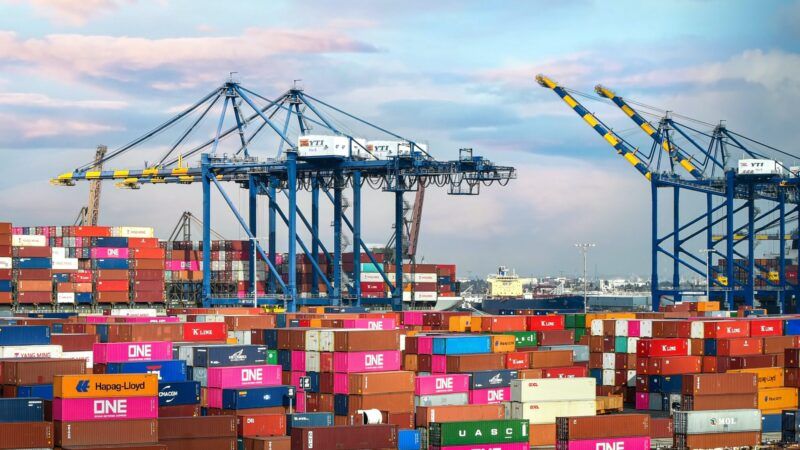America's Ports Need More Robots, but the $1 Trillion Infrastructure Bill Won't Fund Automation
The one thing that would most help increase efficiency at America's lagging ports is also the one thing that Biden's union allies dislike the most.

A lack of robots is one of the single biggest problems among the many logistical issues currently tangling America's supply chains.
At most major ports around the world, the cranes that unload shipping containers from boats to trucks are largely automated. That means they can operate around the clock at lower cost and—extra importantly right now—have zero risk of catching COVID-19. One recent study found that cranes at the mostly automated port in Rotterdam, Netherlands, are roughly 80 percent more efficient than cranes at the Port of Oakland, California, where humans still man the controls. In other words, it takes nearly twice as long to unload the same ship in Oakland as it would in Rotterdam.
One of the major hurdles to automation is the expense. It can cost as much as $500 million to install new, fully automated terminals at existing ports, according to the Journal of Commerce, a trade publication. Even if it might make sense to do that in the long run, short-term considerations keep American ports operating at their current, less efficient status quo.
Conveniently, Congress has just passed a $1.2 trillion infrastructure spending bill—one that includes $17 billion for port infrastructure. Of that $17 billion, about $2.6 billion is specifically earmarked for defraying the cost of upgrading equipment at America's ports, nominally to reduce air pollution.
If you were a member of Congress looking to spend a bunch of money to immediately and meaningfully upgrade American infrastructure in a way that would help solve the current supply chain logjams, automating ports should be at or near the top of the list. It's quite literally a no-brainer.
The bad news, however, is buried on page 308 of the 1,600-plus page bill: "The term 'zero-emission port equipment or technology' means human-operated equipment or human-maintained technology."
Yes, the subsidies doled out as part of President Joe Biden's bipartisan infrastructure deal are expressly forbidden from being used to automate operations at American ports. Instead, taxpayers will spend billions to upgrade existing cranes with lower-emissions alternatives that won't actually work any faster or cheaper. It's a major missed opportunity.
Why? Biden's close ties to labor unions probably have something to do with it. Along with the cost, unions are the biggest reason why American ports don't have more robots. When an automated terminal was introduced at the Port of Los Angeles a few years ago, the politically powerful longshoreman's union that represents dockworkers threw a fit.
But the automated terminals were a hit with truck drivers who work at the port. The Los Angeles Times reported in 2019 that drivers, who are paid by the delivery, were thrilled to have more reliable loading schedules, instead of having to wait around for hours to pick up a container. One truck driver told the paper that automation meant no longer having to "wait hours and hours in long lines" because the dockworkers decided to "leave early to go to lunch and come back late."
The Biden administration is currently leaning on America's biggest west coast ports, in Los Angeles and Long Beach, to operate 24/7 in order to deal with shipping backlogs. But that shift will take time, as the ports have to hire more workers to make it happen.
Automated ports in places like Norfolk, Virginia, meanwhile, are handling record volumes with no backlogs, according to the Journal of Commerce. "With the automation, you can rework your yard to say, 'Okay, while I was expecting to be loading Ship A first, I'm now loading Ship B first,′ and can keep import flow fluid," Stephen Edwards, CEO and executive director of the Port of Virginia, told the Journal in September.
Ports should invest in automation regardless of whether Congress is subsidizing that transition, of course. But if lawmakers are going to approve huge amounts of new spending to upgrade American infrastructure, it's fair to wonder why one of the most useful upgrades is expressly forbidden. It looks like Congress and the White House are more interested in cowing to unions than helping fix America's supply chain problems.
Show Comments (77)